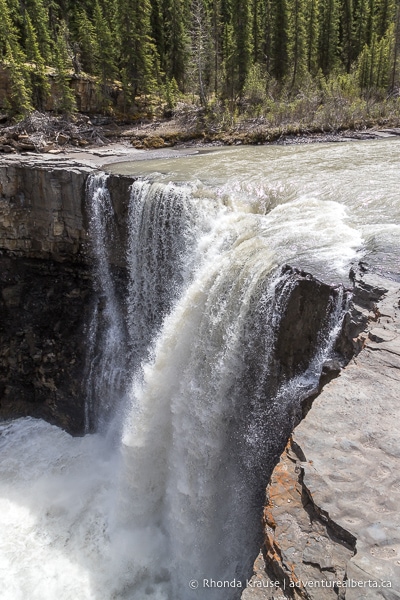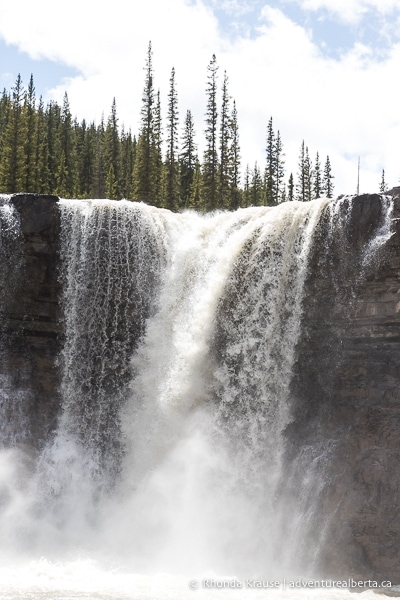Purchases made through links earn us a small commission, at no extra cost to you.
The Crescent Falls hike is an active way to discover one of Alberta’s most beautiful waterfalls.
While you can drive to the observation deck at the brink of the waterfall, the easy hike along the top of Bighorn Canyon offers a stunning panoramic view of Crescent Falls. From the trail you get a wide view of the two-tiered, crescent-shaped waterfall and its plunge pools. If you’re up for a little detour on an unmaintained trail, you can even walk down to the base of the upper falls.
.jpg)
Crescent Falls Hike
Distance: 4.9 km round trip (not including the detour to the base of the falls)
Difficulty: Easy
Elevation Gain: 71 m
Surface: Dirt
Trail Type: Out and Back
Time: 1 hr 15 min- 1.5 hrs (allow for an additional 15- 20 minutes if you take the optional trail to the base of Crescent Falls)
Trailhead: The Bighorn Canyon lookout along the road into Crescent Falls Provincial Recreation Area. There’s a road sign marking it and you’ll see a small parking lot.
.jpg)
Crescent Falls Trail Description
The Crescent Falls hike starts from the Bighorn Canyon lookout. To the right of the viewpoint you’ll see a path with a faded sign and two big rocks blocking the entrance to the trail. This is the path that you’ll be following upstream along the top of Bighorn Canyon to Crescent Falls.
.jpg)
.jpg)
The hike begins by walking on a flat, shaded path through the trees. Soon the forest opens up to a view of the Bighorn River flowing at the bottom of a deep canyon.
.jpg)
.jpg)
The path continues along the top of the canyon with groups of trees separating it from the canyon’s edge. Eventually views of the canyon disappear as the trail leads slightly away from it and into the forest.
.jpg)
.jpg)
The next section of the Crescent Falls trail is not particularly noteworthy as it’s surrounded by trees. There are plenty of blind corners and shrubs along the edge of the path so make sure to make noise on the trail in case there’s a bear nearby.
.jpg)
As you walk further through the forest, you’ll start to hear the sound of Crescent Falls plummeting into the canyon. Watch for a break in the trees to get your first glimpse of the falls. It’s not the greatest view yet, but a sneak peak of what’s to come.

Once you cross a small wooden bridge you’ll come to a fork in the trail. Going right is a shortcut to the waterfall, but the path going left is where you’ll see one of the best views of Crescent Falls.
.jpg)
.jpg)
Heading left at the fork, the trail moves through the forest towards Bighorn Canyon before looping back to the main trail. About three-quarters of the way into the loop you’ll reach an incredible spot for taking pictures of Crescent Falls.
.jpg)
From this point you’ll see Crescent Falls in its entirety- both the upper and lower falls- against a backdrop of snowy peaks. This is something you don’t get to see at the main observation point at the end of the trail, so it’s worth lingering here for a while to take it all in.
.jpg)
.jpg)
Once you tear yourself away from the view, finish walking the loop and continue towards the falls. Again, there’s not much to see except for trees until you almost reach the falls.
.jpg)
Just before the main viewing area you may notice a side trail off to the left with a warning sign. This is the path that leads down to the base of the upper falls, but more on that later.
Continuing straight, the trail soon arrives at the edge of the canyon where you’ll be able to safely view the falls from behind a railing. Here you’ll see the observation deck jutting out beside the brink of the falls. It’s a minor downhill walk to this platform.
.jpg)

This main viewpoint puts you close to the falls where you get a good sense of the amount of water plunging into the canyon every second. The view may not showcase the full beauty of the falls, but it’s undeniably impressive to witness such a force of water.

From this point you can also look one way down the Bighorn Canyon and the other way up the Bighorn River.
.jpg)
If you want to take a break before hiking back on Crescent Falls Trail, visit the day use area opposite the parking lot at the falls. Cross the wooden bridge to get to the picnic sites where you’ll find tables, firepits, and outhouses.
.jpg)
.jpg)
Before leaving Crescent Falls, you might be interested in venturing down to the base of the falls. As you walk back in the direction you came, look for the sign and trail that disappears into the canyon. It’s marked “danger- travel not advised” because the trail is steep with some loose rocks and at the bottom there’s a rock slab that could be slippery with mist from the waterfall. There are no safety barriers preventing a tumble into the river. If you decide to do this trail it’s at your own risk– make sure you have proper hiking footwear and stay well away from the moving water and cliff edges.
.jpg)
If you choose to go down the trail, there’s the steeper main path or a secondary route that people have trodden along the canyon wall that switchbacks through the trees, using the natural landscape as steps.
.jpg)
.jpg)
At the bottom of the trail there are some trees and beyond them is a rock slab where you can see the falls. The area is wide enough that you have plenty of room to stay away from the edge of the cliff. The upper falls are stunning from here and you don’t need to get close to them (or the cliff ledge) for a great picture.
.jpg)
.jpg)
If the conditions are good, this is a wonderful place to sit and listen to the sound of rushing water. Just don’t let the beauty of Crescent Falls distract you from keeping safety in mind.
.jpg)
.jpg)
When you’re ready to leave the falls, it’s a short but steep climb up to the main trail. The route back to the trailhead is on the same path you took to the falls, but this time keep straight to take the shortcut instead of the side loop to the viewpoint.
Review of the Crescent Falls Hike
The Crescent Falls hike is a worthy alternative to driving to the observation deck at the top of the falls. The trail is not too long or difficult and provides opportunities for solitude that you won’t likely get at the main Crescent Falls viewpoint.

It’s not the most scenic or exciting of trails in David Thompson Country (especially when compared to Siffleur Falls trail, another easy waterfall hike nearby), but the sweeping view of the upper and lower falls backed by mountains is reason enough to do this hike.

Tips for Hiking Crescent Falls Trail
Location: Crescent Falls are located in Clearwater County in west central Alberta. They are part of the Crescent Falls Provincial Recreation Area 25 km southwest of Nordegg.
Getting to Crescent Falls Trailhead: If coming from Edmonton, Calgary, or Red Deer, you will pass through Rocky Mountain House and take Highway 11 (the David Thompson Highway) directly to the turn to Crescent Falls Provincial Recreation Area.
- The road into the park isn’t paved and has several sections of potholes.
- Watch for a sign indicating a lookout (it’s before the falls). This is where the trailhead is.
Best Time to Hike Crescent Falls Trail: Crescent Falls can be visited year round but the Crescent Falls hike is best done between May and October.
- Crescent Falls is ridiculously busy on summer weekends, almost unpleasantly so. Try to visit on a weekday or outside of July and August.
Facilities: The day use area near the main Crescent Falls lookout has outhouses and picnic sites.
- Crescent Falls Provincial Recreation Area also has a small, well-treed campground with 22 RV sites, 7 tent sites, and 2 equestrian sites with hitching rails.
Visitor Guidelines and Safety: There have been incidents at the falls resulting in injuries and fatalities so be sure to not get close to the canyon wall, river, waterfall and its plunge pools. Stay behind barriers where they are provided.
Gear and What to Bring: Regular running or walking shoes are fine but you’ll want something with a sturdy sole since there are areas of exposed roots on the trail.
- Bring water and some snacks to enjoy at the falls.
.jpg)
Nearby Hikes
You may also enjoy these nearby trails:
Shop for Crescent Falls Merchandise
Visit our store for more Alberta, nature, and adventure inspired products.

.jpg)
.jpg)
.jpg)


